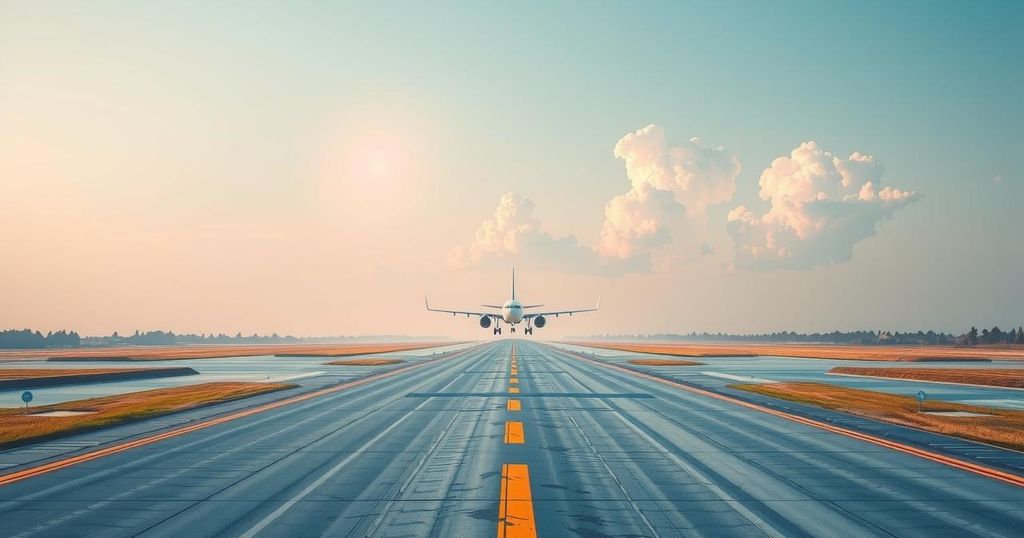Syria’s interim President Ahmad al-Sharaa visited Saudi Arabia on February 2, 2025, marking his first trip abroad. This visit suggests Syria’s intention to pivot from its alliance with Iran towards stronger ties with Saudi Arabia. The trip included meetings with Saudi leadership aimed at rebuilding relations and addressing the country’s post-war reconstruction and sanction relief efforts.
On February 2, 2025, Syria’s interim President Ahmad al-Sharaa embarked on his inaugural international visit to Saudi Arabia, signaling a potential shift in Damascus’s alliances away from Iran. Accompanied by Foreign Minister Asaad al-Shaibani, the duo arrived in Riyadh aboard a Saudi aircraft, which was prominently marked with the Saudi flag. The visit, highlighted on Saudi state television, underscores a strategic reorientation in Syrian foreign relations.
The Syrian flag flew alongside Saudi Arabia’s as al-Sharaa disembarked in formal attire, indicating a significant diplomatic gesture. During his visit, he was scheduled to meet with Saudi Crown Prince Mohammed bin Salman, the principal authority in the kingdom. Historically, Saudi Arabia has funded opposition factions against former President Bashar Assad, although these groups have faced limitations against Assad’s regime, bolstered by support from Iran and Russia.
Al-Sharaa’s political ascent followed a decisive offensive led by his group, Hayat Tahrir al-Sham (HTS), which has distanced itself from its previous affiliations with al-Qaida. The new leadership is attempting to redefine its public persona by adopting a more contemporary image, including appointing women to influential positions and nurturing connections with Syria’s Christian and Shiite Alawite communities. This strategy extends to diplomatically distancing itself from Iran and Russia.
Currently, Iran’s diplomatic presence in Damascus remains inactive, reflecting tensions in their alliance post-conflict. Russia seeks to sustain its military presence in Syria, having supported Assad during the civil strife. Both nations’ hesitance appears to stem from Syria’s ongoing effort to gain Western recognition and alleviate crippling sanctions critical for its reconstruction following a prolonged conflict.
Saudi Foreign Minister Prince Faisal bin Farhan’s visit to Damascus in January highlights Riyadh’s proactive engagement in dialogue aimed at sanction relief for Syria. Unlike Turkey and Qatar, Saudi Arabia restored ties with Assad in 2023, indicating an evolving regional landscape. The removal of sanctions would facilitate reconstruction and bolster their diplomatic relations.
Despite governmental advancements, Syria’s interim government remains challenged by militant threats, notably from the Islamic State group. A recent tragic incident in Manbij resulted in four civilian casualties due to a car bomb explosion, underscoring the ongoing instability within the country. Turkish-backed rebel groups previously seized Manbij as part of an effort to establish a buffer zone along the Syrian border.
The geopolitical landscape in Syria has undergone significant transformations since the outbreak of civil conflict in 2011, prompting shifting alliances among various regional powers. Following the Arab Spring protests, Syria became a battleground involving numerous factions, with foreign influence intensifying throughout the conflict. Iran, Russia, and Saudi Arabia have played key roles in supporting different sides of the crisis, affecting the balance of power within the country and complicating reconstruction efforts post-war.
In conclusion, Syria’s interim President Ahmad al-Sharaa’s visit to Saudi Arabia marks a crucial step in redefining Syria’s foreign policies, particularly in distancing itself from Iran. The ongoing diplomatic efforts by Riyadh signify a possible alliance realignment that may facilitate Syria’s rehabilitation following years of conflict while also addressing internal security challenges posed by militant groups. The outcome of these developments may significantly impact the region’s future stability and Syria’s reconstruction prospects.
Original Source: www.thehindu.com






